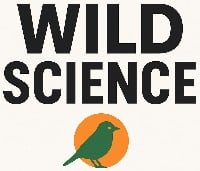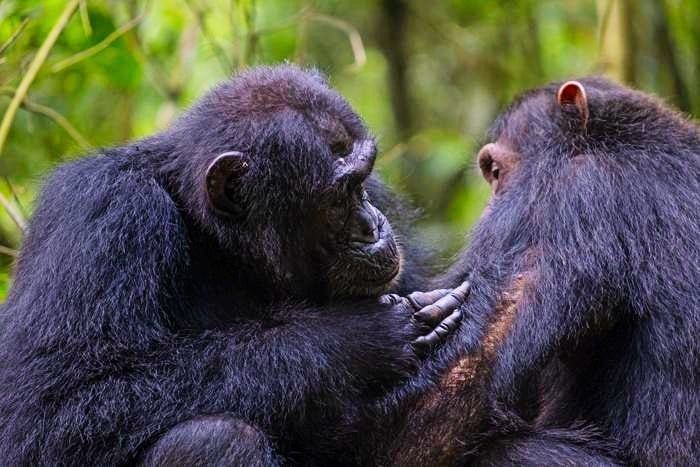Researchers studying chimpanzees in Uganda have documented something remarkable — these apes don’t just treat their own injuries with medicinal plants, but also provide healthcare to injured community members.
This discovery, published Wednesday in Frontiers in Ecology and Evolution, suggests that prosocial healthcare in our closest relatives may be more widespread than previously recognized, potentially illuminating the evolutionary roots of human medical practices.
The Surprising World of Chimpanzee First Aid
Deep in Uganda’s Budongo Forest, a chimpanzee named KO carefully plucks leaves from an Argomuellera macrophylla plant, chews its stem bark, and methodically applies the masticated material to a wound on his knee. In another observation, a juvenile female mimics her mother’s wound care technique, folding and chewing medicinal leaves before gently dabbing them on her mother’s injury.
“Our research helps illuminate the evolutionary roots of human medicine and healthcare systems,” explained Dr. Elodie Freymann of the University of Oxford, who led the study. “By documenting how chimpanzees identify and utilize medicinal plants and provide care to others, we gain insight into the cognitive and social foundations of human healthcare behaviors.”
Medical Toolkit of the Forest
The research team documented 41 cases of healthcare behaviors across two chimpanzee communities — Sonso and Waibira — drawing on over three decades of observations, video evidence, and direct field research. They identified several distinct wound treatment techniques:
- Direct wound licking, which removes debris and potentially applies antimicrobial compounds from saliva
- Finger licking followed by pressing on wounds
- Leaf-dabbing, where leaves are used as compresses on injuries
- Chewing plant materials and applying them directly to wounds
- Hygiene behaviors, including cleaning genitals with leaves after mating
Many of the plants selected by the chimpanzees have known medicinal properties. The researchers identified several species, including Acalypha sp., Alchornea floribunda, and Pseudospondias microcarpa, which have documented antibacterial, antifungal, and anti-inflammatory properties. These same plants are traditionally used by local human communities to treat wounds and infections.
Caregivers Beyond Kinship
Perhaps most striking was the discovery of seven cases of “prosocial care” — one animal treating another’s wounds or helping remove dangerous snares. While some care was provided between relatives, more than half the cases involved unrelated community members.
“These behaviors add to the evidence from other sites that chimpanzees appear to recognize need or suffering in others and take deliberate action to alleviate it, even when there’s no direct genetic advantage,” said Freymann.
The research revealed no pattern in which individuals were more likely to give or receive care — males cared for females, females for males, and all age groups participated in providing assistance.
Adapting to Threats
The Budongo chimpanzees face unique health challenges. While there are no natural predators, they experience high rates of human-caused injuries. Approximately 40% of individuals in the Sonso community have been observed with snare injuries from traps set by hunters targeting other animals.
Could these elevated risks have influenced the development of their healthcare behaviors? The researchers suggest that, much like predation pressure might enhance social cohesion, anthropogenic threats may foster more frequent prosocial care.
The team observed multiple cases where chimps attempted to help remove dangerous snares from others — a behavior that requires recognizing the problem, understanding the solution, and taking action to assist a struggling community member.
Evolution of Empathy and Medicine
What drives a chimpanzee to risk exposure to infection by treating another’s wound? The researchers point to empathy, a trait shared with humans that appears to underlie directed altruism.
The finding that chimp healthcare isn’t limited to close relatives raises fascinating questions about the evolutionary development of medicine. Could these behaviors represent a primitive form of the institutionalized healthcare systems humans later developed?
While the research team acknowledges some limitations in their study — including differences in how habituated the two communities were to human observation — their work provides compelling evidence that the roots of human medical practices may stretch deep into our evolutionary past.
As Dr. Freymann and colleagues continue their research, they hope to better understand which social and ecological factors influence when and why chimpanzees provide care. This understanding could have implications not just for evolutionary science, but potentially for conservation efforts aimed at protecting these remarkable animals and the medicinal plant resources they depend on.
Discover more from Wild Science
Subscribe to get the latest posts sent to your email.

